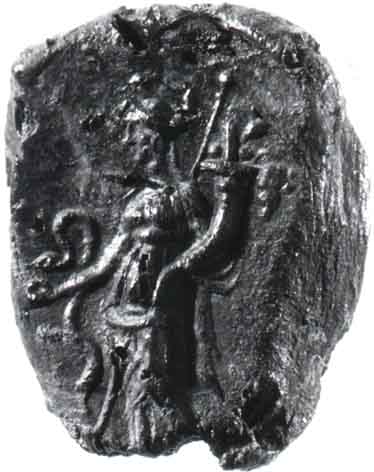

Click here to return to newsletter contents.
 |
Kedesh is located in northern Israel, on its modern border with Lebanon. For much of antiquity control of this area passed back and forth between the Jewish tribe of Naphthali and the Phoenician inhabitants of nearby Tyre. During the Hellenistic era it came under the dominion of the Greeks, first the Ptolemies and later (after 200 BCE) the Seleucids. Under Seleucid rule it appears to have been the site of a regional administrative center, whose inhabitants were Hellenized Phoenicians and whose chief official most likely reported directly to the Seleucid monarch or his representative. The Kedesh bullae thus have the potential to inform us in ways never before possible on issues of self-representation, interaction, and personal identity among Phoenicians, Greeks, and Romans.
Bullae are tiny (average 15 mm) clay pellets, which carry impressions of individuals’ seal rings and were commonly used to close and notarize papyrus documents in the Persian, Hellenistic, and Early Roman eras. The Kedesh bullae were recovered for the most part from a single room in a large Hellenistic administrative building, which was abandoned around 150 BCE and later partially burned. The fire preserved the originally unbaked bullae but destroyed the papyrus documents.
The concentration of the bullae in a single room of a building the size and plan of which are most closely paralleled by Persian- and Hellenistic-period regional palaces led us to believe that the group constitutes the remains of an official archive. The number of bullae testifies that the Kedesh archive served as a repository for a large number of records. What kind of transactions would these documents have recorded; who took part in them? The answers to these questions can be furthered through a detailed analysis of the bullae, their iconography and subject matter, and comparison of the total collection with other extant Hellenistic archives. This was my task for the year.
The first stage in my work on the Kedesh archive was to examine the bullae, in conjunction with photographs, in order to establish a typology of recurring images and assign every bulla to a category. For much of the year every flat surface in my Jerusalem apartment was covered with piles of photographs in various stages of classification. Eventually I found some 90 types, including 32 different gods and goddesses, 33 species of animals, and 23 symbols. Many of these classes were further subdividable by pose and attribute. For example, the 115 representations of the goddess Tyche came in 28 variations of pose and/or attribute. In turn, the impressions in these smaller subclasses could be differentiated by variations in size and style. All this information, including an array of technical details, was entered in a database. After all this sorting, I realized that very few seal rings were represented more than once in the Kedesh archive and that it contained sealings of upward of 1,500 individuals.
In the end, some 1,765 of the bullae were readable. In terms of subject and style the collection is overwhelmingly Greek, with 75 percent of the readable bullae bearing Greek mythological/anthropomorphic figures or animals and symbols common in the Greek repertoire. Another 20 percent carry Greek-style portraits; a small subset of the portraits are executed in a Roman veristic style. For the most part these are impressions from the kind of seal rings one would expect private individuals to use on documents such as sales of property, wills, marriage contracts, and the like. Very few of the seals can be definitely identified as “official.” Chief among these are a group of nine that carry the sign of Tanit and the inscription “he who is over the land” in Phoenician. Added to this group are a small number of recognizable official Seleucid symbols, such as the anchor, of which we have seven examples, and the dolphin representing Tyre, of which we have five. The official or nonofficial status of the portraits is problematic. These are for the most part idealized representations of Seleucid monarchs. It is thought that such portraits were not used exclusively by the kings or their representatives but often taken by private individuals.
The bullae from Kedesh take their place among a dozen or so such finds from throughout the Hellenistic world from Carthage in the west to Seleucia on the Tigris in the east. They are among the very few found in a sealed primary deposit and the largest group for which it can be convincingly argued that the entire archive has been recovered. Some such archives are “official” in the sense that they constitute royal or municipal repositories of public records. For example, in Seleucia more than 50 percent of the bullae discovered in a clearly public building carry official salt tax stamps. Another public archive, situated in the temple complex at Hellenistic Uruk, contained seals of Seleucid officials such as the chreophylax. But many of the ancient archives are collections of personal records kept in individuals’ houses or deposited in the care of private bankers, such as the 16,000+ bullae from the “house of the seals” on Delos.
The archive from Kedesh falls somewhere between the official and the nonofficial ends of the spectrum. It is housed in a public building but not one designed to be exclusively an archive. Around 5 percent of the impressions may be identified as official; none carry inscriptions of royal bureaucrats.
Much more work remains to be done on the Kedesh bullae, but it is already clear that they present a unique reflection of the mixed cultural milieu of the Hellenistic Levant.
Sharon Herbert
Copyright © 2003 The Kelsey Museum of Archaeology, University of Michigan. All rights reserved.